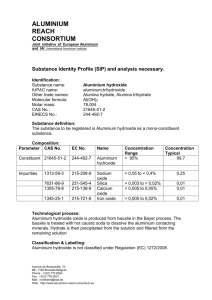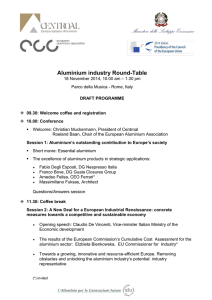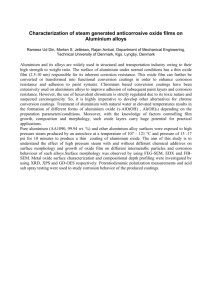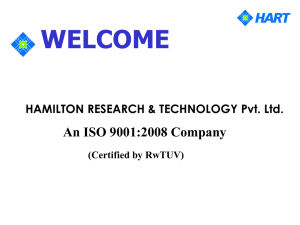Potential Health Effects from Exposure to Aluminium and Aluminium
advertisement
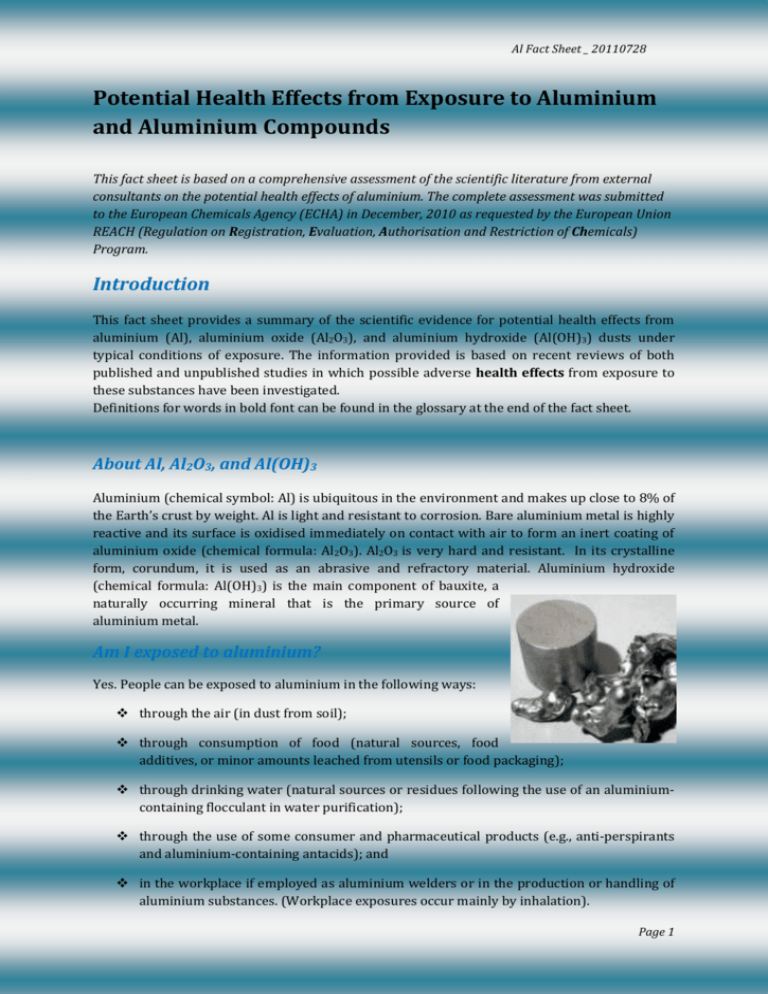
Al Fact Sheet _ 20110728 Potential Health Effects from Exposure to Aluminium and Aluminium Compounds This fact sheet is based on a comprehensive assessment of the scientific literature from external consultants on the potential health effects of aluminium. The complete assessment was submitted to the European Chemicals Agency (ECHA) in December, 2010 as requested by the European Union REACH (Regulation on Registration, Evaluation, Authorisation and Restriction of Chemicals) Program. Introduction This fact sheet provides a summary of the scientific evidence for potential health effects from aluminium (Al), aluminium oxide (Al2O3), and aluminium hydroxide (Al(OH)3) dusts under typical conditions of exposure. The information provided is based on recent reviews of both published and unpublished studies in which possible adverse health effects from exposure to these substances have been investigated. Definitions for words in bold font can be found in the glossary at the end of the fact sheet. About Al, Al2O3, and Al(OH)3 Aluminium (chemical symbol: Al) is ubiquitous in the environment and makes up close to 8% of the Earth’s crust by weight. Al is light and resistant to corrosion. Bare aluminium metal is highly reactive and its surface is oxidised immediately on contact with air to form an inert coating of aluminium oxide (chemical formula: Al2O3). Al2O3 is very hard and resistant. In its crystalline form, corundum, it is used as an abrasive and refractory material. Aluminium hydroxide (chemical formula: Al(OH)3) is the main component of bauxite, a naturally occurring mineral that is the primary source of aluminium metal. Am I exposed to aluminium? Yes. People can be exposed to aluminium in the following ways: through the air (in dust from soil); through consumption of food (natural sources, food additives, or minor amounts leached from utensils or food packaging); through drinking water (natural sources or residues following the use of an aluminiumcontaining flocculant in water purification); through the use of some consumer and pharmaceutical products (e.g., anti-perspirants and aluminium-containing antacids); and in the workplace if employed as aluminium welders or in the production or handling of aluminium substances. (Workplace exposures occur mainly by inhalation). Page 1 Al Fact Sheet _ 20110728 The solubility of a metal salt in water is an important factor in determining the amount of metal ion that actually enters the blood stream, a quantity known as bioavailability. Aluminium, aluminium oxide and aluminium hydroxide are poorly soluble in water1, 2, 3. Less than 0.1% of these substances are absorbed while passing through the gastrointestinal tract4, 5. Only a small fraction of these substances is absorbed after being inhaled6. The scientific evidence, including a study in humans7, also suggests that the bioavailability of aluminium following dermal exposure is low. What does the science say about aluminium and health effects? Neurological Effects Dialysis encephalopathy, a degenerative neurological syndrome, was observed in patients on kidney dialysis who had been exposed to very high levels of aluminium in contaminated dialysate and phosphate-binders – changes in dialysis procedures have now eliminated this problem. An area of past and continuing debate is the possible role of aluminium in the development and progression of Alzheimer’s Disease and possibly other neurotoxic effects that may contribute to declines in cognitive function with age. Based on the available scientific literature, neurotoxic effects are not expected at the levels of aluminium to which the general public is typically exposed. A recent guideline study8 has demonstrated mild neurological effects in rats exposed to high levels of aluminium. These effects were only observed at aluminium levels a thousand-fold higher than what is typically found in treated drinking water and food. Harlan Laboratories Ltd, UK. (2010). Al Metal. Determination of water solubility. Project No.: 2962/0001. January 4, 2010. A study conducted at the request of the Aluminium REACH Consortium. 2 Harlan Laboratories Ltd, UK. (2010). Al Oxide. Determination of water solubility. Project No.: 2962/0002. January 4, 2010. A study conducted at the request of the Aluminium REACH Consortium. 3 Harlan Laboratories Ltd, UK. (2010). Al Hydroxide. Determination of water solubility. Project No.: 2962/0003. UK. January 4, 2010. A study conducted at the request of the Aluminium REACH Consortium. 4 Priest, N.D., Newton, D., Talbot, B., McAughey, J., Day, P., Fifield, K. (1998). Industry-sponsored studies on the biokinetics and bioavailability of aluminium in man. In T.V. O’Donnell, N.D. Priest (Eds.), Health in the aluminium industry: managing health in the aluminium industry. London, UK : Middlesex University Press. 5 Priest, N.D. (1997). The Harwell Series Human Volunteer Studies on the Biokinetics and Bioavailability of Aluminium. A compilation of reports. AEA Report No. AEA-EE-0206. United Kingdom. 1997. 6 Priest, N.D. (2004). The biological behaviour and bioavailability of aluminium in man, with special reference to studies employing aluminium-26 as a tracer: review and study update. Journal of Environmental Monitoring, 6, 375403. 7 Flarend, R., Bin, T., Elmore, D., & Hem, S. L. (2001). A preliminary study of the dermal absorption of aluminium from antiperspirants using aluminium-26. Food & Chemical Toxicology, 39, 163-168. 8 ToxTest TEH-113. (2010). One-Year Developmental and Chronic Neurotoxicity Study of Aluminium Citrate in Rats. ToxTest Final Report. Alberta Research Council Inc, Canada. Project No. TEH -113. April 20, 2010. 1 Page 2 Al Fact Sheet _ 20110728 Recent studies investigating whether there is a link between aluminium levels in drinking water and Alzheimer’s Disease have provided inconclusive results. Considering all sources of evidence related specifically to Alzheimer’s Disease, the current weight of evidence does not support a primary role for aluminium in causing this condition. The potential role of aluminium in other diseases involving cognitive decline is under active investigation. At present, there is no clear evidence that such effects are caused by aluminium. Worker exposures to aluminium are controlled by regulatory standards. The weight of evidence, which is strongly influenced by recent occupational studies9,10 does not support a neurotoxic risk to workers exposed to airborne aluminium, or aluminium oxide and aluminium hydroxide dusts in workplaces which conform to regulatory standards. Effects on the Lungs There is no evidence for a chemical-specific fibrogenic effect due to aluminium metal powder. When not appropriately controlled, several airborne substances in pot-rooms may contribute to an irritation effect in the lungs. The evidence points to a role for fluoride-containing substances11, 12, 13, or sulphur dioxide14. The available evidence suggests that aluminium oxide and aluminium hydroxide behave as “nuisance dusts” under current controlled occupational exposure conditions. Results from workplace studies do not demonstrate allergic reactions or sensitisation from exposure to aluminium compounds. The weight of evidence, supported by negative results from animal dermal sensitisation studies15, 16 suggests a very limited sensitisation potential for aluminium metal, aluminium oxide, and aluminium hydroxide dusts on exposure by inhalation. Kiesswetter, E., Schäper, M., Buchta, M., Schaller, K. H., Rossbach, B., Kraus, T., Letzel, S. (2009). Longitudinal study on potential neurotoxic effects of aluminium: II. Assessment of exposure and neurobehavioral performance of Al welders in the automobile industry over 4 years. International Archives of Occupational & Environmental Health, 82, 1191-1210. 10 Kiesswetter, E., Schäper, M., Buchta, M., Schaller, K. H., Rossbach, B., Scherhag, H., Zschiesche, W., Letzel, S. (2007). Longitudinal study on potential neurotoxic effects of aluminium: I. Assessment of exposure and neurobehavioural performance of Al welders in the train and truck construction industry over 4 years. International Archives of Occupational and Environmental Health, 81, 41-67. 11 ATSDR. Agency for Toxic Substances and Disease Registry. 2008. Toxicological Profile for Aluminum. September 2008. Atlanta, GA.: US Department of Health & Human Services, Public Health Service. 12 Krewski, D., Yokel, R.A., Nieboer, E., Borchelt, D., Cohen, J., Harry, J., Kacew, S., Lindsay, J., Mahfouz, A.M., Rondeau, V. (2007). Human health risk assessment for aluminium, aluminium oxide, and aluminium hydroxide . Journal of Toxicology & Environmental Health, Part B: Critical Reviews, 10, 1-269. 13 Donoghue, A.M., Frisch, N., Ison, M., Walpole, G., Capil, R., Curl, C., Di Corleto, R., Hanna, B., Robson, R., Viljoen, D. (2011). Occupational asthma in the aluminum smelters of Australia and New Zealand: 1991–2006. American Journal of Industrial Medicine, 54, 224-231. 14 Abramson, M.J., Benke, G.P., Cui, J., de Klerk, N.H., Del Monaco, A., Dennekamp, M., Fritschi, L., Musk, A.W., Sim, M.R. (2010). Is potroom asthma due more to sulphur dioxide than fluoride? An inception cohort study in the Australian aluminium industry. Occupational and Environmental Medicine, 67, 679-685. 15 Basketter, D.A., Lea, L.J., Cooper, K.J., Ryan, C.A., Gerberick, G.F., Dearman, R.J., Kimber,I. (1999). Identification of metal allergens in the local lymph node assay. American Journal of Contact Dermatitis, 10, 207-212. 9 Page 3 Al Fact Sheet _ 20110728 Effects on Fertility The weight of evidence, including considerations of bioavailability and results from animal studies, does not indicate effects on reproduction. Effects on Infants and the Developing Foetus The available data, including considerations of bioavailability and negative results from animal studies, do not provide clear evidence for a risk of developmental effects in humans on exposure to aluminium, or aluminium oxide and aluminium hydroxide dusts. Cancer The weight of evidence from animal, human and in-vitro studies does not support a cancer hazard in humans exposed to aluminium metal, aluminium oxide, or aluminium hydroxide by the oral, inhalation, or dermal routes. Although the process, “Aluminium Production” has been classified by IARC17 as Group 1 (Carcinogenic to Humans), this does not imply that aluminium per se is the responsible agent; the evidence supports a role for known carcinogens such as polycyclic aromatic hydrocarbons (PAHs)18 in the workplace rather than a role for aluminium in this effect. The weight of evidence from several epidemiological of studies does not support an association between breast cancer and aluminium-containing antiperspirants19. The weight of evidence, including considerations of bioavailability and negative results from recent guideline studies20, also does not support the existence of a mutagenic or genotoxic hazard in humans on exposure to aluminium, or aluminium oxide and aluminium hydroxide dusts by the oral and inhalation routes. Lab Research Ltd, Hungary. (2010). Aluminium hydroxide: A skin sensitisation study in the guinea pig using the Magnusson and Kligman method. Final Report. Study No.: 09/164-104T, February 03, 2010. A study conducted at the request of the Aluminium REACH Consortium. 17 IARC. International Agency for Research on Cancer. (1990). Chromium, nickel and welding. In IARC Monographs on the evaluation of carcinogenic risks to humans. Vol 49: IARC Scientific Publications, Lyon, France. 18 Baan, R., Grosse, Y., Straif, K., Secretan, B., El Ghissassi, F., Bouvard, V., Benbrahim-Tallaa, L., Guha, N. Freeman, C., Galichet, L, Cogliano, V. (2009). A review of human carcinogens- Part F: chemical agents and related occupations. The Lancet Oncology, 10, 1143-1144. 19 Namer, M., Luporsi, E., Gligorov, J., Lokiec, F., & Spielmann, M. (2008). [The use of deodorants/antiperspirants does not constitute a risk factor for breast cancer]. Bulletin du Cancer, 95, 871-880. 20 Covance Laboratories Ltd. (2010). Aluminium hydroxide: induction of micronuclei in the bone marrow of treated rats. Covance Laboratories Ltd, 2010. Report. Covance Study Number 8221368. 16 Page 4 Al Fact Sheet _ 20110728 Other Effects Aluminium is present in the human diet. For adults, the daily intake of aluminium has been estimated at about 2.5-13.5 mg and can be much higher (500 mg or more) in individuals taking antacids containing aluminium hydroxide21. Normal dietary levels of intake of aluminium are not associated with adverse health effects. Case reports of sensitisation by aluminium following exposure of the skin are rare22, 23 . A recent guideline study in animals exposed to aluminium hydroxide24 was negative, as was an industrysponsored study in which aluminium oxide was investigated. The weight of evidence suggests limited sensitisation potential for aluminium metal, aluminium oxide, and aluminium hydroxide dusts on exposed skin. Further Research Although the potential health effects of aluminium have been subject to extensive scientific evaluation, further research in certain areas is warranted. Clarification of the neurological effects seen at high levels of exposure in laboratory animals is required, as are further data on the pharmacokinetics of aluminium. Potential health effects following the interactions between aluminium and other metals such as iron, copper, and zinc should also be investigated. IPCS. International Programme on Chemical Safety. (1997). Aluminium. Environmental Health Criteria 194. Geneva: World Health Organization. 22 Kligman, A.M. (1966). The identification of contact allergens by human assay. III. The maximization test; a procedure for screening and rating contact sensitizers. The Journal of Investigative Dermatology, 47, 393-409. 23 Kligman, A.M. (1966). The identification of contact allergens by human assay. II. Factors influencing the induction and measurement of allergic contact dermatitis. The Journal of Investigative Dermatology, 47, 375-392. 24 Lab Research Ltd, Hungary. (2010). Aluminium hydroxide: a skin sensitisation study in the guinea pig using the Magnusson and Kligman method. Final Report. Study No.: 09/164-104T, February 03, 2010. A study conducted at the request of the Aluminium REACH Consortium. 21 Page 5 Al Fact Sheet _ 20110728 Overall Summary Aluminium is the most abundant metallic element on Earth. It is present in the human diet at moderate levels, less than 15 mg being ingested daily. Aluminium metal is used as a structural material in the construction, automotive, and aircraft industries, in the production of metal alloys, in the electrical industry, in cooking utensils, and in food packaging. Aluminium compounds are used as coagulants in water treatment, as antacids, antiperspirants, and food additives. A number of different organisations have suggested dietary intake limits for aluminium. A recent decision by the Joint FAO/WHO Expert Committee on Food Additives (JECFA) established a provisional tolerable weekly intake (PTWI) of 2 mg aluminium/kg body weight. The PTWI applies to all aluminium compounds in food, including food additives25. This fact sheet provides a summary of the evidence for potential health effects from aluminium (Al), aluminium oxide (Al2O3), and aluminium hydroxide (Al(OH3)) dusts under exposure conditions typically found in the workplace, general environment, and in the diet. At current exposure levels, based on the available data, there is no evidence that these compounds are associated with adverse health outcomes in the general population. 25 For further information see: http://www.who.int/foodsafety/chem/jecfa/summaries/Summary74.pdf . Page 6 Al Fact Sheet _ 20110728 Glossary Alzheimer’s Disease: Alzheimer's Disease is a progressive, degenerative disease of the brain, which causes thinking and memory to become impaired. It is the most common form of dementia. Dementia is a syndrome consisting of a number of symptoms that include loss of memory. (For further information see: http://www.alzheimer.ca/english/disease/intro.htm). Bioavailability: The quantity or fraction of a chemical that actually enters the blood stream. Carcinogen: An agent that increases the risk of cancer in humans. Dialysis Encephalopathy: A degenerative neurological syndrome, characterized by the gradual loss of motor, speech, and cognitive functions. Fibrogenic Effect: An adverse health effect associated with the development of fibrous tissue in the lungs, resulting in a loss of the tissue’s ability to transfer oxygen into the bloodstream. Gastrointestinal Irritation: A condition associated with irritation and inflammation of the stomach and intestines. The main symptoms are gastric and/or abdominal pain, mild to moderate diarrhoea, and nausea, with or without vomiting. Genotoxicity: The capacity of a chemical or an agent to alter genetic material (DNA) in living cells. Guideline Study: A study conducted according to an internationally agreed upon testing method, such as the OECD Test Guideline established by the Organization for Economic Cooperation and Development (OECD). Hazard: “The intrinsic property of the agent that makes it capable of causing adverse effects to occur in humans or the environment, under specific conditions of exposure.” (For future information see: http://www.hc-sc.gc.ca/ahcasc/alt_formats/hpfb-dgpsa/pdf/pubs/risk-risques-eng.pdf). Metal Ion: A metal is an element, compound, or alloy characterized by a capacity to conduct electricity and heat. Metal ions (specifically cations (positively charged ions) are formed by electron loss. Mutagenicity: The capacity of a chemical or an agent to induce or increase the frequency of mutation in an organism. Neurotoxic Effect: An adverse effect on nervous system cells and tissues associated with pathological changes in the structure or function of the nervous system. Nuisance Dusts: Dust particles which are poorly soluble in water and have low sensitization potential and toxicity (other than by inflammation or the mechanism of “lung overload”). Risk: “A measure of both the harm to human health that results from being exposed to a hazardous agent, together with the likelihood that the harm will occur.” (For future information see: http://www.hc-sc.gc.ca/ahc-asc/alt_formats/hpfbdgpsa/pdf/pubs/risk-risques-eng.pdf). Skin Sensitisation: Skin sensitisation (allergic contact dermatitis) is an immune response to an environmental agent. In humans, sensitization responses may be characterised by pruritis (itching), erythema (redness), oedema (swelling), and blisters. Sensitisation Potential: The ability to cause an allergic reaction that results in the development of hypersensitivity (a condition in which the allergic response to a second or later exposure is greater than the response to the first exposure to the substance) to an environmental agent. Weight of Evidence: Weight of evidence refers to the overall level of scientific evidence that an environmental agent may cause adverse health effects in humans. Page 7
